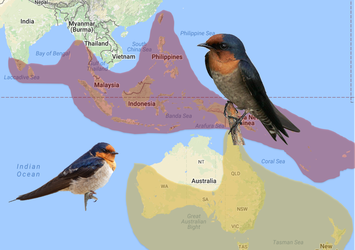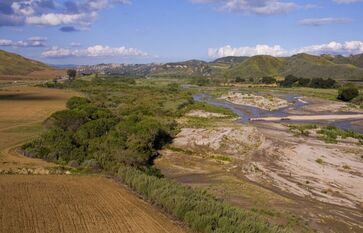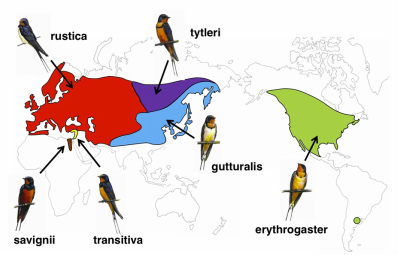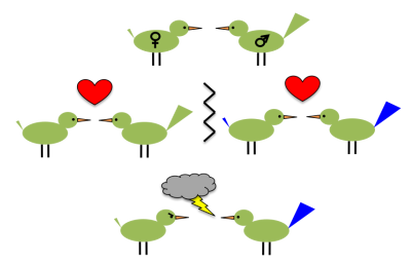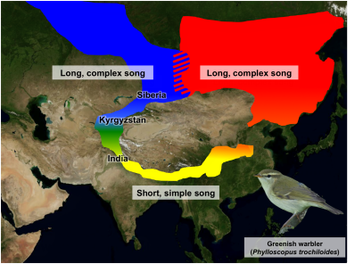|
Anthropogenic effects on divergence and gene flow in Pacific and welcome swallows
We are studying the origins and evolution of commensal nesting behavior in Pacific and welcome swallows across Southeast Asia and the Pacific as part of an NSF grant. We are using whole-genome sequencing approaches to examine population structure, patterns of divergence, and evidence for adaptation to human environments across commensal and non-commensal lineages. We are also using species distribution modeling to assess how habitat availability has changed over time as a consequence of human landscape modification, and demographic models to assess population size changes in response to human land use change. In collaboration with Amanda Hund from Carleton College and researchers in Malaysia, Japan, Fiji, Sri Lanka, and Tahiti, we have sampled broadly across the Pacific and welcome swallow ranges, with more sampling planned in the next years. Thus far we have identified two new species and extensive variation in dispersal propensity in insular vs. continental species. Relevant papers: Broyles, Myers et al. 2023 Evolution |
|
Biodiversity and habitat use in heterogeneous agroecosystems
We are studying the effects of wildlife biodiversity on pest management in a complex citrus-avocado agroecosystem in the Santa Clara River Valley in Ventura Country, California. This project is funded by the CSU Agricultural Research Institute with co-PIs Drs. Erin Questad, Rachel Blakey, Adam Lambert, Ted Stankowich, Hamutahl Cohen and David Still, and collaborators at UCANR and The Nature Conservancy. We are using camera trapping, passive acoustic monitoring, point counts, and observations to assess habitat use by bird, pollinators, small mammals, bats, and mesocarnivores across a landscape comprised of orchards, protected riparian habitat, urban sprawl, and National Forest land. We are further using experimental planting of native vegetation and pest monitoring to assess ecosystem services rendered by wildlife on citrus and avocado orchards throughout the region. We are recruiting students to work on this project- get in touch if you are interested! |
|
Speciation genomics in barn swallows
A a postdoc Liz worked on a project in Rebecca Safran's lab on the roles of sexual and natural selection in shaping population divergence and reproductive isolation in the barn swallow (Hirundo rustica) complex. In collaboration with many international ornithologists, I used a combination of intensive fieldwork and next-generation sequencing to characterize patterns of phenotypic and genotypic divergence in six globally distributed barn swallow subspecies. Read more about this project here. I continue to collaborate with the Safran lab on questions related to this project. Related papers: Scordato and Safran 2014 Avian Research, Safran et al 2016 Molecular Ecology, Scordato et al 2017 Molecular Ecology, Turbek, Scordato and Safran 2018 TREE, Wilkins et al 2018 BJLS, Liu et al 2018 J. Ornithology, Smith et al 2018 Molecular Ecology, Scordato et al 2020 Ecology Letters, Liu et al 2020 BJLS, Schield et al 2021 Molecular Ecology, Turbek et al 2022 Evolution |
|
The roles of sexual selection and ecology in speciation
Liz has worked on several large review projects examining both the theoretical and empirical evidence for roles of natural and sexual selection in population divergence. As part of two NESCent working groups, I worked on clarifying predictions for how sexual selection interacts with ecological variation, as well as reviewed the empirical literature to synthesize empirical data on the role of ecological variation in influencing sexually selected traits and associated mate preferences. I also recently worked on a review of the contribution of male competition to speciation, derived from a symposium on this topic at ISBE 2016. Related papers: Scordato et al 2014 Journal of Heredity; Safran et al 2013 TREE; Safran et al 2012 Current Zoology, Kopp, Servedio et al 2018 American Naturalist, Tinghitella, Lackey, Martin et al 2018 Behavioral Ecology, Lackey et al. in revision |
|
Ecological correlates of divergent sexual selection
The primary focus of Liz's PhD research was identifying causes of divergence in sexually selected traits in the greenish warbler (Phylloscopus trochiloides) ring species complex, with the goal of determining how geographical variation and covariation in these traits leads to the formation of reproductive barriers. Using experimental and observational data, I showed that female choice, male-male competition, and habitat interact in complex but predictable ways to drive divergence in song traits used in mate choice and prezygotic isolation in this incipient species complex. Related papers: Alcaide, Scordato et al 2014 Nature, Scordato and Kardish 2014 Journal of Animal Ecology, Scordato 2017 Animal Behaviour, Scordato 2018, Evolution |
